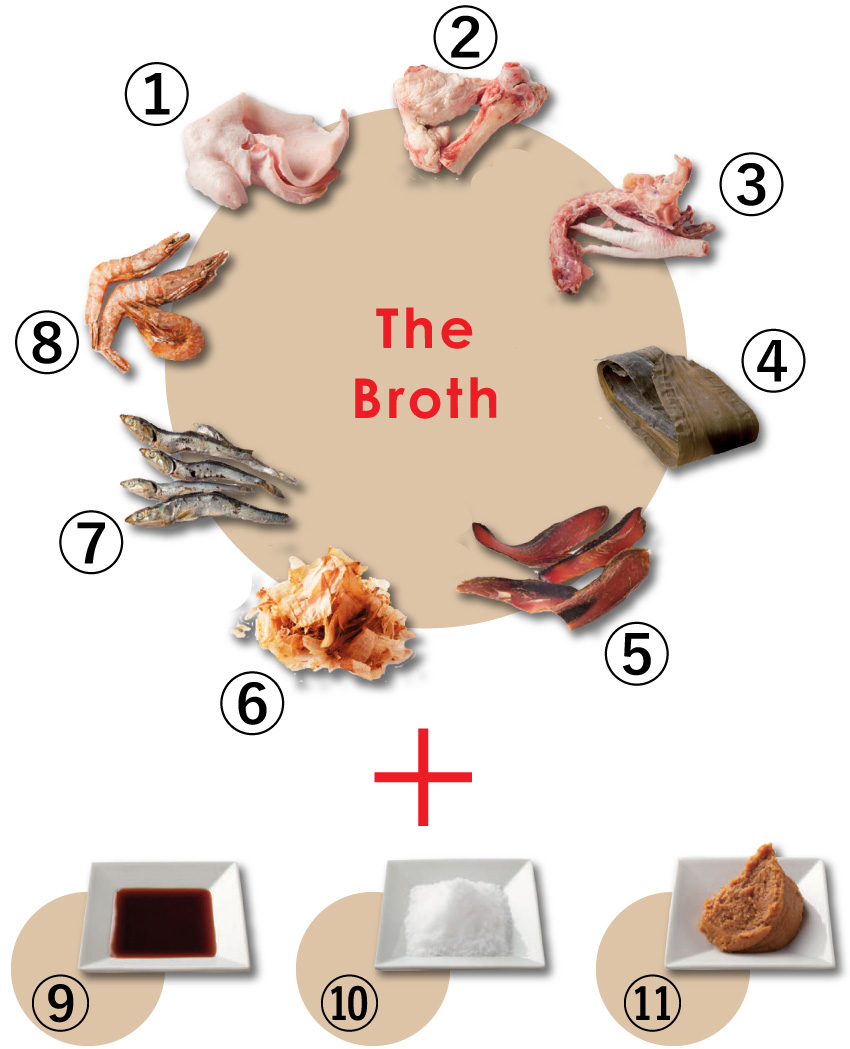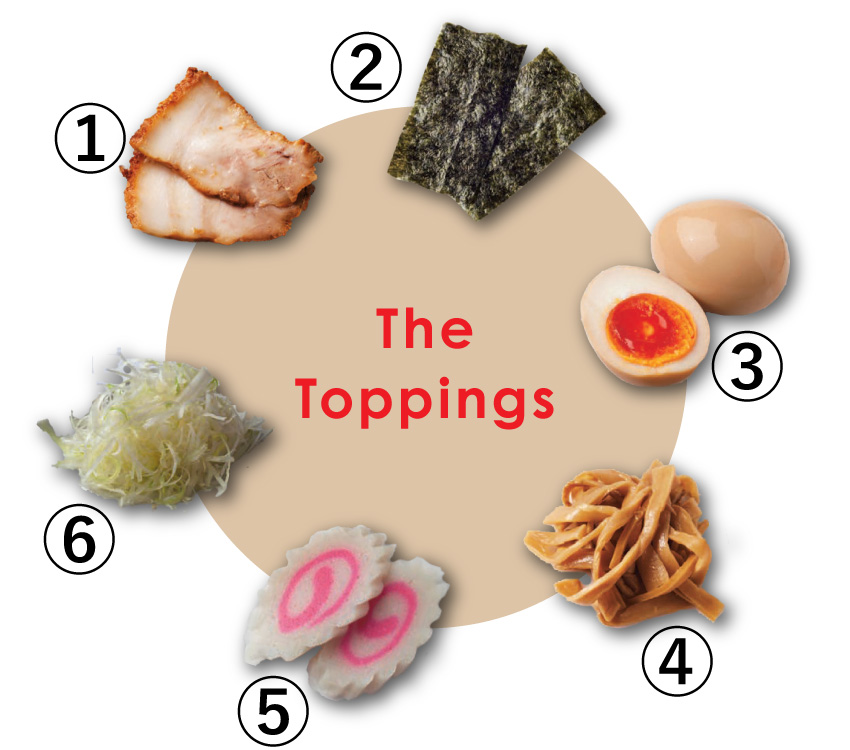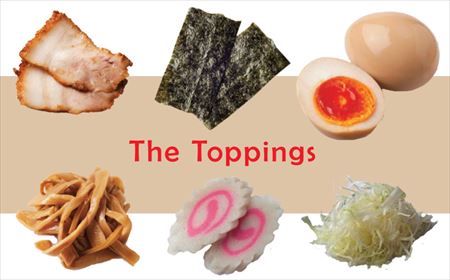The Broth
The broth for ramen is usually made from a base of chicken, pork, seafood, or vegetables. The chickens may be specialized breeds like Nagoya Cochin or Silkie; the whole chicken may be used, or parts such as necks and feet. Pork- and seafood-based stocks may vary likewise.
Whatever the base, the stock is then seasoned with soy sauce, miso, or salt, the proportions of stock to seasoning painstakingly calibrated for optimum flavor.

①Back fat
Back fat, taken from the pork shoulder,gives ramen broth refined body, flavor, and depth. Back fat may be added to tonkotsu broth, or rendered into liquid form and drizzled on top of the soup.
②Pork bones
These are a key ingredient in cloudy white tonkotsu broth. The knuckle bones, which are called genkotsu (fist) because of their resemblance to a human fist, are especially prized for the refined flavor they impart to the stock.
③Chicken bones
Rich in glutamic acid and gelatin, chicken carcasses-bones stripped of their meat-make a full-flavored stock. Neckbones or feet alone may also be used.
④Kombu kelp
One common type of dashi, or soup stock, is made by placing sun-dried kombu in cold water, which is then brought to a simmer. Mainly harvested in Hokkaido, kombu comes in many varieties, including ma-kombu and Rishiri kombu.
⑤Thick-shaved katsuobushi(skipjack flakes)
Katsuobushi is made from skipjack tuna meat, which is boiled, smoked, and then dried. An essential ingredient in seafoodbased soups, thick-shaved katsuobushi is ideal for prolonged simmering, and produces a robust flavor.
⑥Thin-shaved katsuobushi
Thinly shaved ribbons of katsuobushi are used to make a mild-tasting stock. Other types of shaved dried fish such as frigate tuna, sardines, or horse mackerel are also sometimes used to make fish stock.
⑦Niboshi
Niboshi are small fish, usually pilchards, that are boiled then dried. More and more shops are specializing in ramen with a prominent niboshi flavor.
⑧Shrimp
Dried shrimp, as well as fresh shrimp heads, may be used to make stock. Ebisoba,a new variety of ramen featuring noodles in a shrimp-based broth, is becoming increasingly popular.
⑨Soy sauce
Japan’s best-known seasoning is available in many varieties—light, dark, tamari, or white. The distinctive characteristics of each type are highlighted in different versions of shoyu ramen.The flavor of shio ramen is influenced by the type of salt used in the soup. Discriminating chefs often choose either sea salt or rock salt for flavoring their soup.
⑪Miso
Miso, a fermented food made from soybeans and sometimes rice or barley, is rich in regional variations. Different types may be blended to produce unique flavors.
Ramen-shop patrons may be presented with a mind-boggling array of options toorderfrom, and making a selection can be daunting. Basically speaking,ramen consists of three elements: the broth,the noodles, and the toppings. The initial sip of the soup, which the chef has taken great pains to create, is the customer’s first indication of whether the ramen is up to snuff. The next factor is the noodles, whose flavor and texture depend on the blend of flours used to make them. Last are the toppings, which range from the orthodox thin-sliced roast pork or simmered egg to signature options that are distinctive to a particular shop. While every element may be tasty in its own right, the most important criterion is how they work together in concert, since the textures and flavors of each influence the overall balance of the dish. The care and attention ramen chefs devote to achieving a harmonious combination rivals that lavished on fine French cuisine. The resulting product reflects their skills, innovative ideas, and passion.
The Toppings
The ingredients chosen to top the noodles add a distinctive flourish to a ramen dish. Even the most traditional of toppings will bear the trademark stamp of each shop, while some chefs may opt for more unusual ingredients to try to create a hit product. Patrons can also order extra toppings for an additional charge. Everybody has their favorite way of eating the toppings: some nibble at them while eating their noodles, while others save them for last.

Pork thigh or belly meat, simmered in a mixture of soy sauce, sugar, and other ingredients, is served in thin slices over noodles. Some shops make their own version from chicken or beef.
Nori is used as a topping in some regions, but not in others. Wrapping a mouthful of noodles in a sheet of nori that has absorbed the soup makes for a tasty treat. Some shops may use sea lettuce, a flakier type of nori, instead.
③Simmered egg
These eggs are cooked and steeped whole in soy sauce or other flavorings. Tradition calls for hard-boiled eggs, but nowadays eggs with a soft-cooked yolk are popular.
④Menma (flavored bamboo shoots)
Menma-sometimes called shinachiku-adds a textural accent to ramen. Menma is made from lactate-fermented sun-dried bamboo shoots that are then flavored with soy sauce or other ingredients.
⑤Negi (scallion)
Naruto cured fish paste Named after the famed Naruto tidal whirlpools in the strait that separates Shikoku from Awaji Island, naruto is easily recognized by its red or pink spiral pattern when sliced. It is usually made from ground pollock.
⑥Negi (scallion)
In Tokyo, the white portion of the scallion is preferred, while in the Osaka region the green part is more popular. Thinly sliced negi adds a pleasant crunch and mild sharpness to the soup.

The Noodles
Ramen noodles contain wheat flour, water, kansui (alkaline water, which imparts chewiness and flavor), eggs, and salt. The noodles usually come in one of three widths: thin (1.3mm), medium (1.7 mm), or thick (1.9 mm). As quality can vary greatly depending on the ingredients and proportions used, many shops order noodles custom-made to their specifications or, increasingly, make their own noodles in-house. Customers can sometimes select the type of noodle used for their ramen, but beginners should let the chef decide.
Photography by Wataru Nishiyama, Ryuichiro Sato,and Hayato Ishiyama.
Text by Mieko Otaki In cooperation with Hayato Ishiyama.
Translation by Julie Kuma
Copy Edit by Katherine Heins


Comments